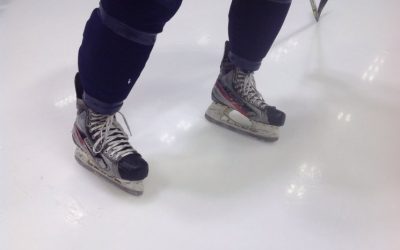Muscular work on the front skate push
Field hockey players spend their summers training to improve their performance on the ice. The main aspect that most players want to improve is skating speed. We know that skating speed depends on the effectiveness of each of the thrusts that enable the player to move forward. To increase this efficiency, the vast majority of field hockey players use weight training (of varying weights) to improve their strength. Is strength development really the best way to increase push-off efficiency?
Numerous studies have attempted to establish a relationship between the strength developed on certain bodybuilding exercises and skating speed (1,2,3). Of all these studies, none has succeeded in finding an exercise for which greater force predicts higher skating speed. This means that thrust efficiency in forward skating depends on factors other than pure force.
First of all, it’s important to understand that the main neuromuscular quality exploited during the push is not force, but power. The difference between these two concepts lies in the speed at which the movement is performed. A forceful movement is always performed at a controlled, often slow, speed, as this allows better regulation of posture and technical gesture. This does not represent power thrust, which is always achieved at maximum speed. The ability to move a load with greater speed is therefore much more useful to the field hockey player than simply being able to lift large loads.
Another decisive factor in developing the efficiency of the forward skating thrust is the player’s ability to make good use of the neuromuscular qualities developed in other contexts (weight training, weightlifting, plyometrics, etc.). For example, an individual with a large muscle mass, but a weak motor repertoire (motor control, agility, coordination, etc.) will surely be less efficient in his pushes than a less strong individual who is able to recruit his muscles well. This deficient motor coordination can be worked on at physical maturity with muscle activation and motor control exercises, but improvements will be difficult and often not transferable to the sporting gesture. Young players therefore need to develop a diversified motor repertoire from an early age.
In short, while strength remains essential, it’s not the only aspect field hockey players should invest time in if they want to improve their forward skating speed. Indeed, working on muscle contraction speed should also be at the heart of field hockey players’ summer development. However, speed work should never be at the expense of movement quality. What’s more, the transferability of neuromuscular quality development into concrete improvements in the sporting gesture will be optimized by effective motor control. As the motor repertoire’s capacity for development is at its peak before the end of physical maturation, a diversification of sporting activities should be encouraged at a young age.
Written by Léandre Gagné Lemieux, M.Sc. kinesiology
References
1. Behm DG, Wahl MJ, Button DC, Power KE, Anderson KG (2005) Relationship between field hockey skating speed and selected performance measures. J Strength Cond Res. 19(2):326-331.
2. Farlinger CM, Kruisselbrink D. Fowles JR (2007) Relationship to skating performance in competitive field hockey players. J Strength Cond Res. 21(3):915-922.
3. Potteiger JA, Smith DL, Maier ML, Foster TS (2010) Relationship between body composition, leg strength, anaerobic power and on-ice skating performance in division I mens’s field hockey athletes. J Strength Cond Res. 24(7):1755-62.
Want to stay on top of new articles before they’re published?
Subscribe to our newsletter.
From the same author
Why is it easier to turn left?
Why is it easier to turn left? MAXIME Sports physiotherapist In a field hockey match, various skating techniques are used to counter the opponent. A technique of choice for quickly changing direction while maintaining good speed is the sharp turn. On the one hand,...

